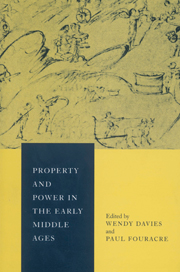Book contents
- Frontmatter
- Contents
- List of maps
- Preface
- List of abbreviations
- Introduction
- 1 The ideology of sharing: apostolic community and ecclesiastical property in the early middle ages
- 2 Teutsind, Witlaic and the history of Merovingian precaria
- 3 Eternal light and earthly needs: practical aspects of the development of Frankish immunities
- 4 The wary widow
- 5 Lordship and justice in the early English kingdom: Oswaldslow revisited
- 6 Adding insult to injury: power, property and immunities in early medieval Wales
- 7 Property transactions and social relations between rulers, bishops and nobles in early eleventh-century Saxony: the evidence of the Vita Meinwerci
- 8 Monastic exemptions in tenth- and eleventh-century Byzantium
- 9 Property ownership and signorial power in twelfth-century Tuscany
- 10 Conclusion: property and power in early medieval Europe
- Glossary
- List of works cited
- Index
10 - Conclusion: property and power in early medieval Europe
Published online by Cambridge University Press: 25 January 2010
- Frontmatter
- Contents
- List of maps
- Preface
- List of abbreviations
- Introduction
- 1 The ideology of sharing: apostolic community and ecclesiastical property in the early middle ages
- 2 Teutsind, Witlaic and the history of Merovingian precaria
- 3 Eternal light and earthly needs: practical aspects of the development of Frankish immunities
- 4 The wary widow
- 5 Lordship and justice in the early English kingdom: Oswaldslow revisited
- 6 Adding insult to injury: power, property and immunities in early medieval Wales
- 7 Property transactions and social relations between rulers, bishops and nobles in early eleventh-century Saxony: the evidence of the Vita Meinwerci
- 8 Monastic exemptions in tenth- and eleventh-century Byzantium
- 9 Property ownership and signorial power in twelfth-century Tuscany
- 10 Conclusion: property and power in early medieval Europe
- Glossary
- List of works cited
- Index
Summary
MODELS
‘Dodo was the domesticus (leading administrator) of Prince Pippin, and he had many estates (possessiones) and many armed men (pueri) in his following.’ This is how the mid-eighth-century author of the ‘Life of St Landibert’ chose to emphasize the power of a dangerous enemy. No less than modern commentators he understood that Dodo's power lay in a combination of office and property, which together provided the resources to support the armed force necessary to protect his interests. Chris Wickham uses a similar formulation to characterize the basis of power in the Carolingian period. Unlike moderns, however, medieval writers were rather more concerned with the effects than with the origins of power. They thought of power in terms of morality and social convention, that is, according to how it was used. Their view of property likewise concentrated upon use, and consequently the question of ownership was generally of less interest to medieval people than the issue of possession and use of property. Here David Ganz's chapter is essential as a guide to the ways in which some medieval people thought about the acquisition and use of property: principally, how they justified it in moral terms. The notion that who possessed and used property was as important as who owned it is one which is partially retained in modern generic definitions of the term ‘property’, for they include both possession and ownership. We have maintained this open-ended definition throughout our discussions in order to deal with the variety and complexity of the medieval use of property.
- Type
- Chapter
- Information
- Property and Power in the Early Middle Ages , pp. 245 - 271Publisher: Cambridge University PressPrint publication year: 1995
- 1
- Cited by



